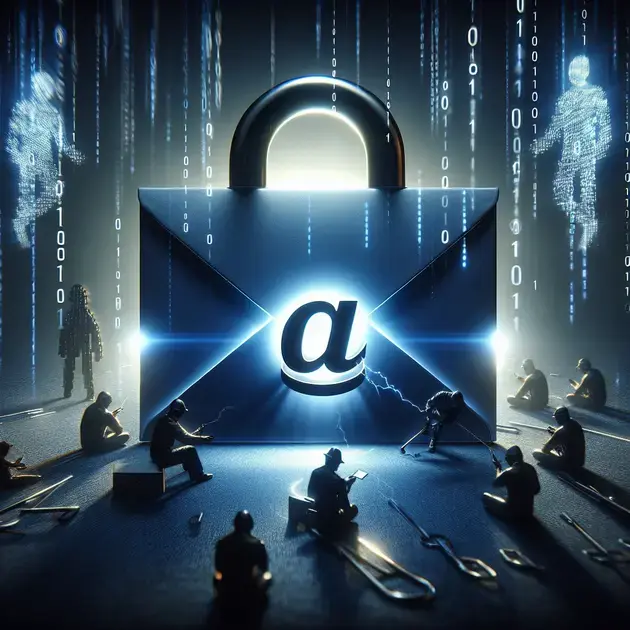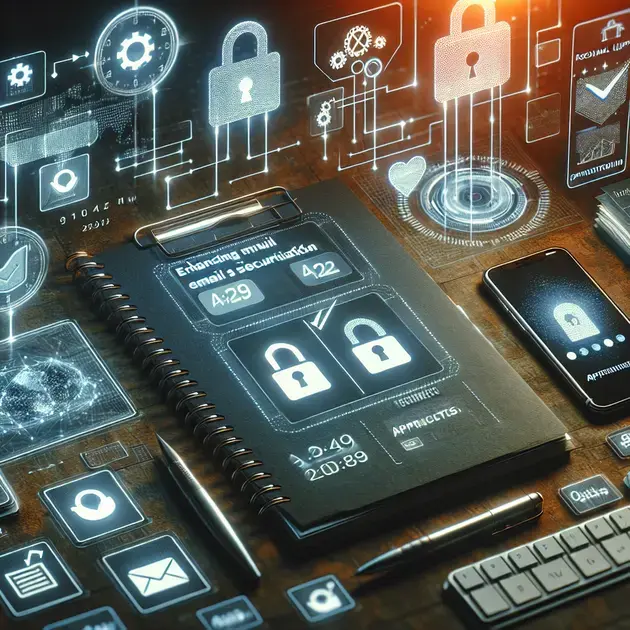Unlocking the Power of Secure Communication: My Email Address is crucial in today’s digital world, where cyber threats are becoming increasingly sophisticated. Securing our online communication has never been more important.
With data breaches and privacy concerns on the rise, it is essential to implement robust measures to protect sensitive information shared via email. This post will explore the latest trends in secure communication and provide practical tips on how to safeguard your email address effectively.
Unlocking the Importance of Secure Email Communication
In today’s digital age, secure email communication is essential to protect sensitive information from falling into the wrong hands. Whether you are sending personal messages or confidential business data, ensuring the security of your emails should be a top priority. By following these steps, you can unlock the importance of secure email communication:
Step 1: Enable Two-Factor Authentication
One of the most effective ways to secure your email communication is by enabling two-factor authentication. This extra layer of security requires you to verify your identity using a second method, such as a unique code sent to your mobile device. Popular email providers like Gmail and Outlook offer this feature to enhance the protection of your account.
Step 2: Encrypt Your Emails
Encryption scrambles the content of your emails into a code that can only be deciphered by the intended recipient. Services like ProtonMail and Tutanota offer end-to-end encryption, ensuring that your messages remain private and secure throughout transmission.
Step 3: Be Wary of Phishing Attempts
Phishing attacks often target email users by tricking them into revealing sensitive information. To safeguard your email address, never click on suspicious links or download attachments from unknown senders. Utilize anti-phishing tools like Microsoft Defender for Office 365 to block malicious emails before they reach your inbox.
Step 4: Regularly Update Your Email Security Settings
Keep your email account secure by regularly updating your security settings. Enable features like spam filters and email scanning to detect potential threats. Services like Secure Email offer comprehensive security options to protect your emails from various cybersecurity risks.
Step 5: Educate Yourself on Email Security Best Practices
Stay informed about the latest email security best practices to effectively safeguard your communication. Websites like StaySafeOnline.org provide valuable resources and tips on enhancing email security, empowering you to make informed decisions when it comes to protecting your online correspondence.
Enhancing Email Security in a Digital Age
With the increasing prevalence of cyber threats, enhancing email security is crucial to safeguard your personal and professional data. By implementing advanced security measures and adopting proactive strategies, you can enhance the security of your email communication in the digital age. Follow these tips to bolster your email security:
Step 1: Use Strong, Unique Passwords
Creating strong, unique passwords for your email accounts is essential in preventing unauthorized access. Consider using a password manager like LastPass or Dashlane to generate and store complex passwords securely.
Step 2: Implement Email Filtering and Blocking
Take advantage of email filtering and blocking tools to prevent malicious emails from reaching your inbox. Services like Barracuda and Mimecast offer advanced filtering capabilities to identify and block suspicious email content.
Step 3: Conduct Regular Security Audits
Regularly audit your email security settings and configurations to identify any potential vulnerabilities. Tools like Qualys and Rapid7 can help you assess the security posture of your email infrastructure and address any weaknesses proactively.
Step 4: Secure Your Email Devices
Secure the devices you use to access your email accounts by installing reputable antivirus software and enabling device encryption. Apps like McAfee Total Protection and Bitdefender provide comprehensive device security features to protect against malware and cyber threats.
Step 5: Train Your Team on Email Security Awareness
Ensure that your team members are well-versed in email security best practices by providing regular training and awareness programs. Platforms like KnowBe4 offer interactive security awareness training modules to educate employees on the importance of email security and how to recognize potential threats.
Tips for Safeguarding Your Email Address
Your email address is a gateway to your online identity, making it a prime target for cyber threats and malicious actors. Safeguarding your email address is crucial to protect your personal information and prevent unauthorized access to your accounts. Follow these essential tips to enhance the security of your email address:
Step 1: Use Alias Email Addresses
Consider using alias email addresses for different purposes to compartmentalize your online presence. Services like 33mail and SimpleLogin allow you to create unique alias addresses that forward emails to your primary inbox, keeping your main email address private.
Step 2: Avoid Publicly Sharing Your Email Address
Avoid sharing your email address on public platforms or websites to minimize the risk of it being harvested by spammers. Utilize contact forms or masked email addresses when communicating online to maintain the privacy of your primary email account.
Step 3: Enable Email Address Privacy Settings
Check the privacy settings of your email account to restrict who can view your email address. Platforms like Gmail and Outlook offer options to control who can see your email address in messages or during online interactions, reducing the exposure of your contact information.
Step 4: Monitor Account Activity Regularly
Regularly monitor the activity of your email account for any suspicious changes or unauthorized access attempts. Set up alerts for unusual login activity and review your account security settings periodically to ensure that your email address remains secure.
Step 5: Keep Your Email Software Updated
Ensure that your email software and applications are regularly updated with the latest security patches and enhancements. Regular updates help address vulnerabilities that could be exploited by attackers to compromise your email address and data.
Mastering the Art of Encrypted Email Communication
Ensuring the security and privacy of your email communication is essential in today’s digital age. Mastering the art of encrypted email communication is a crucial step towards protecting your sensitive information from prying eyes. By encrypting your emails, you can prevent unauthorized access to your messages and safeguard your data from potential threats.
Here is a step-by-step guide on how to master the art of encrypted email communication:
Step 1: Choose a Secure Email Provider
The first step in mastering encrypted email communication is to choose a secure email provider that offers end-to-end encryption. Look for providers that prioritize user privacy and use advanced encryption protocols to protect your emails.
Step 2: Set Up Encryption Tools
Once you have selected a secure email provider, make sure to set up encryption tools like PGP (Pretty Good Privacy) or S/MIME (Secure/Multipurpose Internet Mail Extensions) to encrypt your emails. These tools will ensure that only the intended recipient can decrypt and read your messages.
Step 3: Practice Secure Email Habits
It’s important to practice secure email habits, such as creating strong and unique passwords, enabling two-factor authentication, and being cautious of phishing attempts. By following these best practices, you can enhance the security of your encrypted email communication.
Step 4: Regularly Update Your Encryption Software
Keep your encryption software up to date to ensure that you have the latest security patches and features. Regular updates will help protect your emails from new vulnerabilities and emerging threats.
Step 5: Educate Yourself on Email Security
Stay informed about email security best practices and educate yourself on the latest encryption techniques. By staying up to date on email security trends, you can better protect your sensitive information and maintain secure communication.
Maximizing Email Privacy in Today’s World
In a world where online privacy is increasingly under threat, maximizing email privacy has become more important than ever. By implementing robust security measures and following best practices, you can enhance the privacy of your email communication and safeguard your personal information from unauthorized access.
Here is a comprehensive guide on how to maximize email privacy in today’s world:
Step 1: Use Strong Encryption Protocols
One of the most effective ways to maximize email privacy is to use strong encryption protocols like PGP or S/MIME. These protocols encrypt your emails and ensure that only the intended recipient can decrypt and read the messages, protecting your data from potential threats.
Step 2: Secure Your Devices
Secure your devices with strong passwords, biometric authentication, and encryption to prevent unauthorized access to your email accounts. By securing your devices, you can minimize the risk of data breaches and unauthorized email access.
Step 3: Be Mindful of Email Content
Avoid sharing sensitive information, such as personal details or financial data, via email. Be mindful of the content you include in your emails and refrain from sending confidential information that could compromise your privacy.
Step 4: Regularly Monitor Your Email Accounts
Keep a close eye on your email accounts and regularly monitor for any suspicious activities or unauthorized access. By staying vigilant, you can detect potential security breaches early on and take action to protect your privacy.
Step 5: Avoid Public Wi-Fi for Email Communication
Avoid accessing your email accounts on public Wi-Fi networks, as they are often insecure and prone to hacking. Use a virtual private network (VPN) for secure email communication when connected to public Wi-Fi to maximize your privacy.
Securing Your Email Address: Best Practices
Your email address is a valuable piece of personal information that requires protection from potential threats and security breaches. Securing your email address involves implementing best practices to prevent unauthorized access and maintain the privacy of your communication.
Here are some best practices for securing your email address:
Step 1: Use a Strong Password
Create a strong and unique password for your email account that includes a combination of letters, numbers, and special characters. Avoid using easily guessable passwords like “123456” or “password,” and consider using a password manager for added security.
Step 2: Enable Two-Factor Authentication
Enable two-factor authentication (2FA) for your email account to add an extra layer of security. With 2FA, you will need to provide a second form of verification, such as a code sent to your phone, in addition to your password to access your email account.
Step 3: Keep Your Email Address Private
Avoid sharing your email address on public platforms or websites to prevent it from being harvested by spammers or cybercriminals. Be cautious when providing your email address online and only share it with trusted sources.
Step 4: Regularly Update Your Email Settings
Regularly review and update your email settings to ensure that your privacy and security preferences are up to date. Check for any unusual account activity and set up alerts for login attempts from unknown devices or locations.
Step 5: Use Encryption for Sensitive Emails
Encrypt sensitive emails containing personal or confidential information before sending them to ensure that only the intended recipient can access the content. Utilize encryption tools provided by your email provider or consider using third-party encryption services for added security.
Conclusion
In today’s digital age, mastering the art of encrypted email communication is crucial to safeguarding your sensitive information from potential threats. By following a step-by-step guide that includes choosing a secure email provider, setting up encryption tools, practicing secure email habits, regularly updating encryption software, and educating yourself on email security, you can enhance the security of your communications and protect your data.
Maximizing Email Privacy
With online privacy facing increasing threats, maximizing email privacy has never been more critical. By utilizing strong encryption protocols, securing your devices, being mindful of email content, monitoring your email accounts, and avoiding public Wi-Fi for communication, you can enhance the privacy of your email communication and prevent unauthorized access to your personal information.
Securing Your Email Address
Securing your email address is essential to prevent security breaches and protect the privacy of your communication. By using a strong password, enabling two-factor authentication, keeping your email address private, regularly updating your email settings, and using encryption for sensitive emails, you can ensure the security of your email account and safeguard your personal information.

